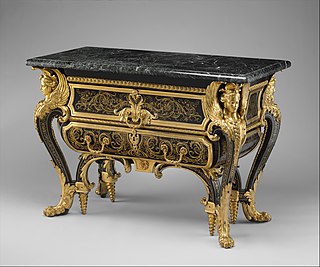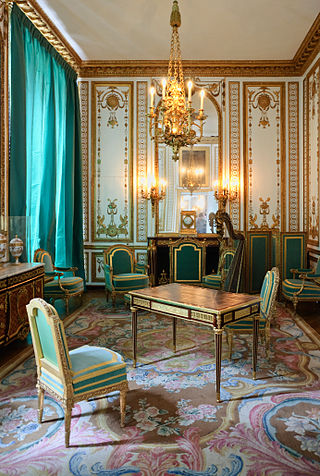A taboret (also spelled tabouret or tabourette) refers to two different pieces of furniture: a cabinet or a stool.
Contents






A taboret (also spelled tabouret or tabourette) refers to two different pieces of furniture: a cabinet or a stool.






As a stool, it refers to a short stool without a back or arms. The name is derived from its resemblance to a drum (diminutive of Old French tabour). [3] [4]
The tabouret acquired a more specialized meaning in 17th-century France at the court of Louis XIV in Versailles, where it allowed courtesans to sit in the presence of the royal family. The court tabouret was an elaborate, upholstered stool with curved wooden legs and tassels, carried by a liveried and wigged servant. Duchesses were automatically granted the honor of sitting in front of the queen. This stool became such a symbol of privilege that when Louis XIV's mother, the Regent Anne of Austria, granted the tabouret to two non-duchesses, such a storm of protest was raised that she had to revoke the order. [5]
In the context of the Arts and Crafts Movement, a taboret is a narrow and tall stand for a plant, lamp, ashtray, or a beverage. [6] It may also be a mission oak book stand shelf, or side table, or end table. [1] [2] [7]
The current sense refers to graphic artists' task furniture, a wheeled, portable stand or cabinet, with drawers and shelves for storage, used to bring supplies to a work area. [8] [9]

Woodworking is the skill of making items from wood, and includes cabinetry, furniture making, wood carving, joinery, carpentry, and woodturning.

Furniture refers to objects intended to support various human activities such as seating, eating (tables), storing items, working, and sleeping. Furniture is also used to hold objects at a convenient height for work, or to store things. Furniture can be a product of design and can be considered a form of decorative art. In addition to furniture's functional role, it can serve a symbolic or religious purpose. It can be made from a vast multitude of materials, including metal, plastic, and wood. Furniture can be made using a variety of woodworking joints which often reflects the local culture.

A desk or bureau is a piece of furniture with a flat table-style work surface used in a school, office, home or the like for academic, professional or domestic activities such as reading, writing, or using equipment such as a computer. Desks often have one or more drawers, compartments, or pigeonholes to store items such as office supplies and papers. Desks are usually made of wood or metal, although materials such as glass are sometimes seen.

Jean-Henri Riesener was a famous German ébéniste (cabinetmaker), working in Paris, whose work exemplified the early neoclassical "Louis XVI style".

A commode is any of many pieces of furniture. The Oxford English Dictionary has multiple meanings of "commode". The first relevant definition reads: "A piece of furniture with drawers and shelves; in the bedroom, a sort of elaborate chest of drawers ; in the drawing room, a large kind of chiffonier." The drawing room is itself a term for a formal reception room, and a chiffonier is, in this sense, a small sideboard dating from the early 19th century.

André-Charles Boulle, le joailler du meuble, became the most famous French cabinetmaker and the preeminent artist in the field of marquetry, also known as "inlay". Boulle was "the most remarkable of all French cabinetmakers". Jean-Baptiste Colbert recommended him to Louis XIV of France, the "Sun King", as "the most skilled craftsman in his profession". Over the centuries since his death, his name and that of his family has become associated with the art he perfected, the inlay of tortoiseshell, brass and pewter into ebony. It has become known as Boulle work, and the École Boulle, a college of fine arts and crafts and applied arts in Paris, continues today to bear testimony to his enduring art, the art of inlay.

In woodworking, a trestle table is a table consisting of two or three trestle supports, often linked by a stretcher, over which a board or tabletop is placed. In the Middle Ages, the trestle table was often little more than loose boards over trestle legs for ease of assembly and storage. This simple, collapsible style remained the most common Western form of table until the 16th century, when the basic trestle design gave way to stronger frame-based structures such as gateleg and refectory tables. Ease of assembly and storage has made it the ideal occasional table, and it remains a popular form of dining table, as those seated are not so inconvenienced as they might be with the more usual arrangement of a fixed leg at each corner.

Paul Hankar was a Belgian architect and furniture designer, and an innovator in the Art Nouveau style.

The Louis XV style or Louis Quinze is a style of architecture and decorative arts which appeared during the reign of Louis XV. From 1710 until about 1730, a period known as the Régence, it was largely an extension of the Louis XIV style of his great-grandfather and predecessor, Louis XIV. From about 1730 until about 1750, it became more original, decorative and exuberant, in what was known as the Rocaille style, under the influence of the King's mistress, Madame de Pompadour. It marked the beginning of the European Rococo movement. From 1750 until the King's death in 1774, it became more sober, ordered, and began to show the influences of Neoclassicism.
An ébéniste is a cabinet-maker, particularly one who works in ebony. The term is a loanword from French and translates to "ebonist".

The Royal Collection of the British royal family is the largest private art collection in the world.

Louis XVI style, also called Louis Seize, is a style of architecture, furniture, decoration and art which developed in France during the 19-year reign of Louis XVI (1774–1792), just before the French Revolution. It saw the final phase of the Baroque style as well as the birth of French Neoclassicism. The style was a reaction against the elaborate ornament of the preceding Baroque period. It was inspired in part by the discoveries of Ancient Roman paintings, sculpture and architecture in Herculaneum and Pompeii. Its features included the straight column, the simplicity of the post-and-lintel, the architrave of the Greek temple. It also expressed the Rousseau-inspired values of returning to nature and the view of nature as an idealized and wild but still orderly and inherently worthy model for the arts to follow.
Italian Baroque interior design refers to high-style furnishing and interior decorating carried out in Italy during the Baroque period, which lasted from the early 17th to the mid-18th century. In provincial areas, Baroque forms such as the clothes-press or armadio continued to be used into the 19th century.

A stool is a raised seat commonly supported by three or four legs, but with neither armrests nor a backrest, and typically built to accommodate one occupant. As some of the earliest forms of seat, stools are sometimes called backless chairs despite how some modern stools have backrests. Folding stools can be collapsed into a flat, compact form typically by rotating the seat in parallel with fold-up legs.

A cabinet is a case or cupboard with shelves or drawers for storing or displaying items. Some cabinets are stand alone while others are built in to a wall or are attached to it like a medicine cabinet. Cabinets are typically made of wood, coated steel, or synthetic materials. Commercial grade cabinets usually have a melamine-particleboard substrate and are covered in a high-pressure decorative laminate, commonly referred to as Wilsonart or Formica.

Furniture created in the Art Nouveau style was prominent from the beginning of the 1890s to the beginning of the First World War in 1914. It characteristically used forms based on nature, such as vines, flowers and water lilies, and featured curving and undulating lines, sometimes known as the whiplash line, both in the form and the decoration. Other common characteristics were asymmetry and polychromy, achieved by inlaying different colored woods.

The furniture of the Louis XV period (1715–1774) is characterized by curved forms, lightness, comfort and asymmetry; it replaced the more formal, boxlike and massive furniture of the Louis XIV style. It employed marquetry, using inlays of exotic woods of different colors, as well as ivory and mother of pearl.

The furniture of Louis XIV was massive and lavishly covered with sculpture and ornament of gilded bronze in the earlier part of the personal rule of King Louis XIV of France (1660–1690). After about 1690, thanks in large part to the furniture designer André Charles Boulle, a more original and delicate style appeared, sometimes known as Boulle work. It was based on the use of marquetry, the inlay of pieces of ebony and other rare woods, a technique first used in Florence in the 15th century, which was refined and developed by Boulle and others working for the King. Furniture was inlaid with thin plaques of ebony, copper, mother of pearl, and exotic woods of different colors in elaborate designs.

Louis XVI furniture is characterized by elegance and neoclassicism, a return to ancient Greek and Roman models. Much of it was designed and made for Queen Marie Antoinette for the new apartments she created in the Palace of Versailles, Palace of Fontainebleau, the Tuileries Palace, and other royal residences. The finest craftsmen of the time, including Jean-Henri Riesener, Georges Jacob, Martin Carlin, and Jean-François Leleu, were engaged to design and make her furniture.
Artist's taboret Designed to keep art supplies handy near an easel